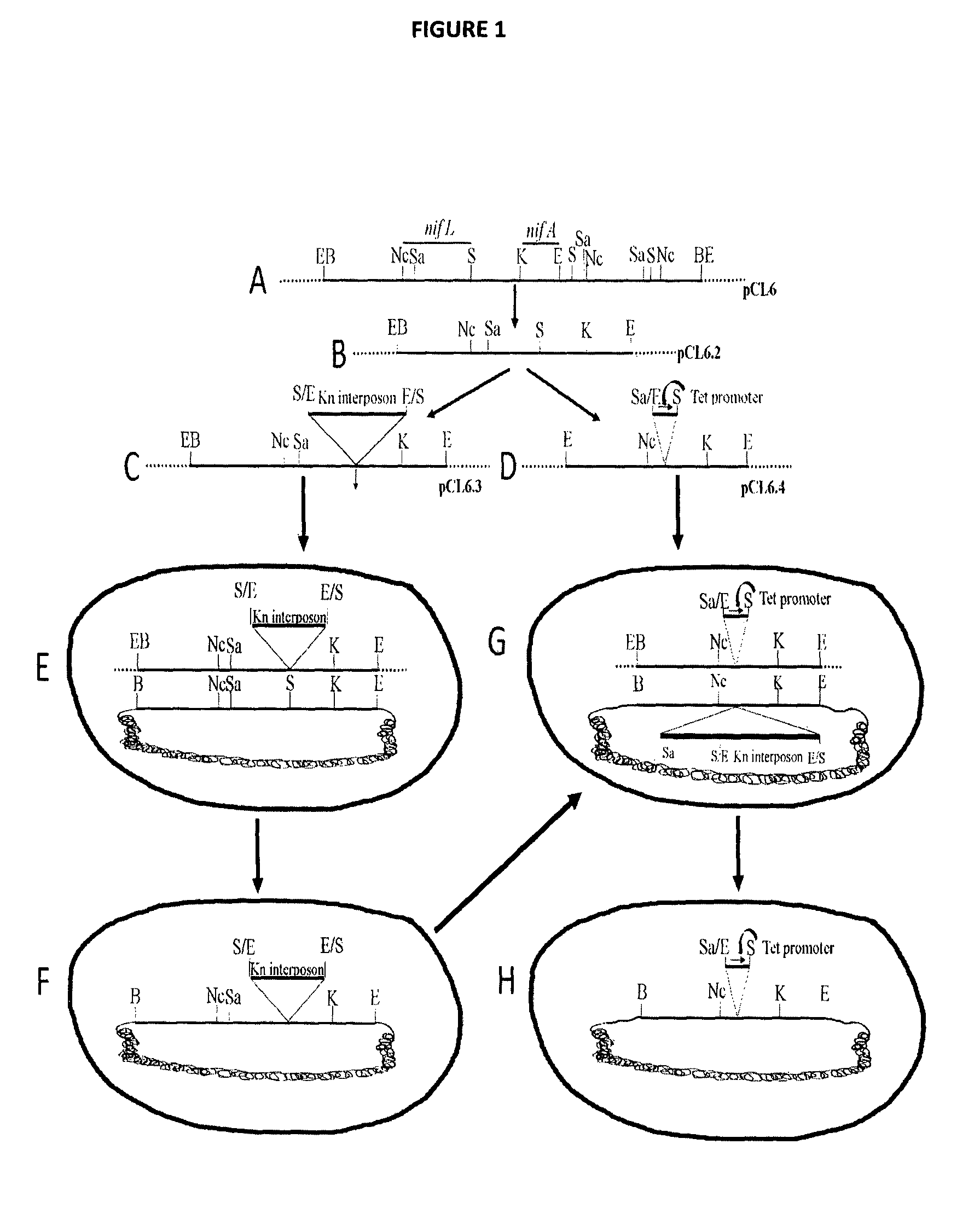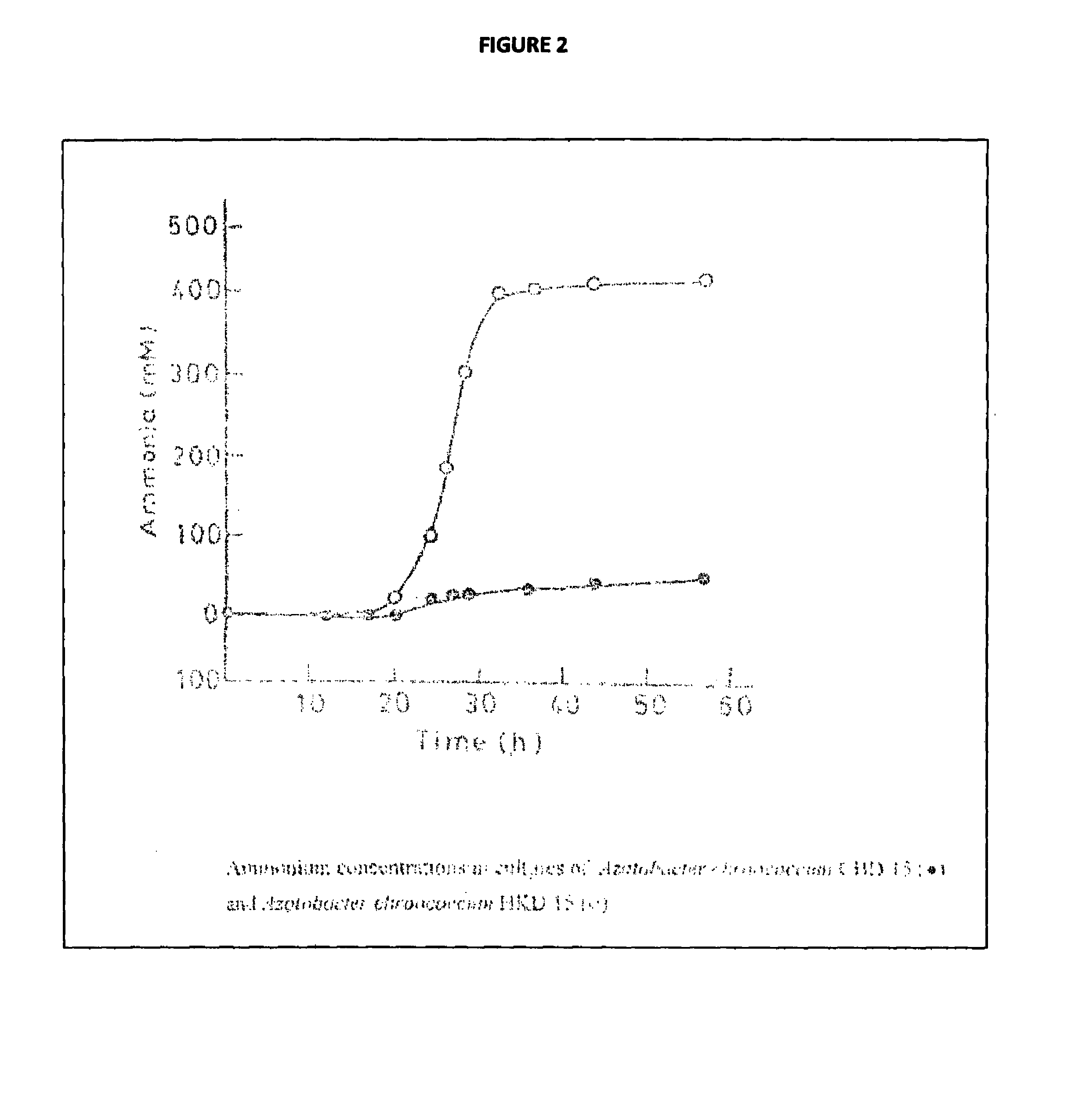Recombinant nitrogen fixing microorganism and uses thereof
a technology of nitrogen fixing microorganisms and recombinant microorganisms, applied in the field of microorganisms and genetic engineering, can solve the problems of plasmids with antibiotic resistance genes, plasmids with oxygen resistance genes, and enzymes responsible for nitrogenase action are very susceptible to oxygen destruction, so as to reduce the application of chemical nitrogenous fertilizers, increase crop yield, and reduce the degradation of soil
- Summary
- Abstract
- Description
- Claims
- Application Information
AI Technical Summary
Benefits of technology
Problems solved by technology
Method used
Image
Examples
example 1
Isolation of nifL and nifA Genes of Azotobacter chroococcum CBD15
[0089]Azotobacter chroococcum CBD15, a strain isolated from the soil at Indian Agricultural Research Institute, Delhi, India, was used in the present study.
[0090]A genomic fragment of 7.5 kb size from the Azotobacter chroococcum CBD15 that contains the nifL gene comprising the nucleotide sequence as set forth in SEQ ID NO: 3 and the nifA genes was isolated using conventional methods and on the basis of homology with the known sequences of the nifL and the nifA genes of Azotobacter vinelandii UW. This fragment was purified and ligated into the cloning vector pUC7 at the BamHI restriction site to obtain a first recombinant vector. This recombinant vector comprising the 7.5 kb fragment was designated as pCL6 (FIG. 1A) and was introduced into competent E. coli cells. The transformed cells were screened using radiolabelled probes and colony hybridization technique.
[0091]The plasmid from these transformed cells harboring the...
example 2
Site-Directed Insertional Mutagenesis of nifL
Insertion of the Interposon ΩKm into nifL of Azotobacter chroococcum CBD15
[0094]The 2.0 kb EcoRI fragment from pHP45 ΩKm (R. Fellay, J. Frey, H. Krisch, 1987; Gene; 52: 147) containing the interposon ΩKm was inserted into the pCL6.2 at the SalI sites of the nifL gene, which was immediately upstream of nifA. This construct is denoted as pCL6.3 and comprises the ‘first’ antibiotic resistance marker gene (Km+) (FIG. 1C). The ampicillin resistance marker gene of the plasmid is denoted as the ‘second’ antibiotic resistance marker gene (Amp+).
Electroporation of Azotobacter chroococcum CBD15 with pCL6.3 for Insertion of the Interposon ΩKm at the nifL Gene in its Genome
[0095]Azotobacter chroococcum CBD15 was electroporated with the recombinant plasmid construct pCL6.3 to obtain the first set of transformed cells. The transformed cells showing kanamycin resistance (Km+) were selected. The cells were assayed for absence of ampicillin resistance (Am...
example 3
Partial Deletion of NifL Gene and Cloning of the pBR322 Constitutive Promoter
[0096]The 375 bp EcoRI-BamHI fragment from pBR322 comprising the constitutive promoter (nucleotides 1 to 377), as set forth in SEQ ID NO: 6, was used.
[0097]A 1.1 kb DNA fragment around the Sal I sites of pCL6.2 was deleted and the EcoRI-BamHI fragment of 375 bp containing the pBR322 constitutive promoter (SEQ ID NO: 6) was inserted at the site of deletion of 1.1 kb DNA fragment around the SalI sites in pCL6.2. This construct containing the constitutive promoter was denoted as pCL6.4 (FIG. 1D).
PUM
| Property | Measurement | Unit |
|---|---|---|
| diameter | aaaaa | aaaaa |
| antibiotic resistance | aaaaa | aaaaa |
| composition | aaaaa | aaaaa |
Abstract
Description
Claims
Application Information
 Login to View More
Login to View More - R&D
- Intellectual Property
- Life Sciences
- Materials
- Tech Scout
- Unparalleled Data Quality
- Higher Quality Content
- 60% Fewer Hallucinations
Browse by: Latest US Patents, China's latest patents, Technical Efficacy Thesaurus, Application Domain, Technology Topic, Popular Technical Reports.
© 2025 PatSnap. All rights reserved.Legal|Privacy policy|Modern Slavery Act Transparency Statement|Sitemap|About US| Contact US: help@patsnap.com


